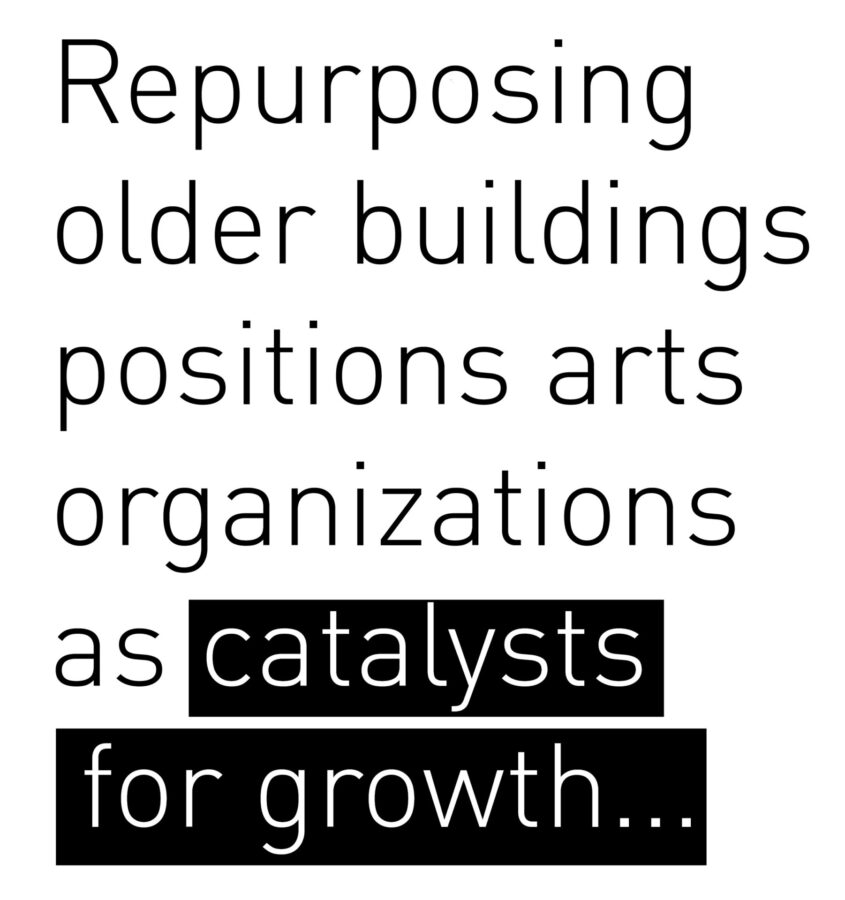Insights
Mar 15, 2022 _ insights
4 Ways Existing Buildings Give Arts Orgs an Advantage
To build or not to build, that is the question. Okay, maybe not one that Shakespeare’s Hamlet ever asked, but one that many arts organizations grapple with as they grow. For arts organizations considering repurposing an existing building, it’s worth noting the unexpected value existing properties can bring.
An existing building—be it a ghost retail space, or a vacant industrial box, or a unique vintage building full of architectural character—can be one of the greatest assets to both grow and anchor arts organizations. The vast array of building stock available in regional rustbelt cities presents arts organizations with distinct opportunities to help achieve their goals.
Consider a few of these advantages:
- Cost-to-Craft Ratio: The most cost-effective and sustainable building is the one that already exists.
- Being Where It’s At: Older structures are often in desirable neighborhoods, within destination districts and nearby supportive businesses.
- A Character All Its Own: Many vintage buildings have a unique character inherent to their age that can be used to differentiate an organization and create a distinctive experience.
- Growing Memories Across Generations: Historic buildings often come with a rich history, shared by a community, that can ground your organization in the hearts and minds of current and future patrons.
Cost-to-Craft Ratio
For budget-sensitive organizations, a well-built old building is often the best way to balance cost and craft. While renovating an existing structure isn’t necessarily cheap, it’s often more affordable and less resource-intensive than building something new of similar quality due to the rising cost of materials and drastically different labor practices.
Contemporary Craft in Pittsburgh’s Lawrenceville neighborhood is an artist-led, mixed-media gallery and studio. When the organization decided to ditch their rent payments for a space of their own, they went with renovating a modest, industrial, concrete box. The minimalistic building chosen allowed Contemporary Craft to maximize their budget by getting a space ready for customization, yet still connected to the building’s original materials. Not to mention, they got a lot of bang for their buck with a low cost per square foot building purchase. It feels good to know that this once industrial space is still dedicated to making.

Being Where it’s At
Arts organizations may decide to seek out the walkable destination districts where their patrons already are. These tend to be in long-established neighborhoods with a wide swath of older buildings near supporting shops, bars, and restaurants.
But it can even happen the other way around. Arts organizations evoke a sense of legitimacy, importance, and permanence wherever they live. As a catalyst for growth, an arts organization that homes itself in a district—with a huge chunk of affordable building stock available for others to follow suit—can breathe new life and new business into that district.
The Ensemble Theatre Cincinnati has long been anchored in Cincinnati’s historic Over-the-Rhine neighborhood. The company has fostered community connections and has grown in a place that reflects their mission of racially equitable and socially-just programming. As Over-the-Rhine has experienced a renaissance in new shops, bars, restaurants, and arts, Ensemble Theatre Cincinnati remains an integral institution in a rapidly transforming district.

A Character All its Own
Maybe it’s the warmth of the materials, the expertly carved wood and stone, the ornate marbles, or the texture of old brick; for many reasons, people are attracted to older buildings. While not every historic building is a tourist destination, each has a unique character inherent to its age that is part of what draws people in.
The Cincinnati Museum Center is housed inside the historic Union Terminal, an Art Deco structure that was once Cincinnati’s largest transit station. Union Terminal’s breathtaking half-dome rotunda lobby exhibits some of the most intricate hand-crafted mosaics in the United States and has been the backdrop of many a selfie. As part of an extensive renovation of this National Historic Landmark, the visitor experience at the Cincinnati Museum Center (comprised of the Natural History Museum, Cincinnati History Museum, and The Children’s Museum as well as a new Holocaust & Humanity Center) was transformed to better support how modern museumgoers move through the space. The renovation added more amenities, classrooms, and made labs – like the paleontology lab- more visible and accessible.

Growing Memories Across Generations
When an arts organization (be it new or established) makes a treasured landmark its home, it further ingrains its image into the fabric of the city, tethering it to its shared history through the built environment.
The Taft Museum of Art has long been the steward of its 200-year-old house—originally designed for people, not priceless paintings. As part of its Bicentennial campaign, the museum invested in its most valuable artifact: the historic home that contains its collection. Acknowledging the importance of their historic museum gives the Taft Museum of Art the opportunity to tell its next story as an organization integral to Cincinnati, today, and into the future.

Whether the relative blank slate of an industrial concrete box, a historic building with unique properties, or an existing building in a destination district, repurposing older buildings can position arts organizations as catalysts for growth, development, and community stewardship.
To learn how we’ve helped clients through the process of building the right facility from the ground up, stay tuned for our next insight.




